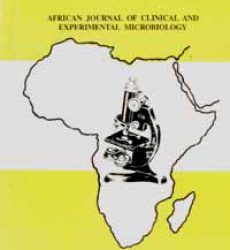Popoola, O. D., Agu, G. C., Oyeyipo, F. M., and *Thomas, B. T.
Department of Microbiology, Olabisi Onabanjo University, Ago Iwoye, Ogun State, Nigeria
*Correspondence to: benthoa2013@gmail.com; ORCID: http://orcid.org/0000-0003-0675-5749
Abstract:
Background: Asymptomatic bacteriuria (ASB) in children is a predisposing factor to symptomatic urinary tract
infection (UTI) that may be complicated by blood stream infections if not appropriately treated with resultant
mortality or morbidity. The objectives of this study are to determine the prevalence of ASB, and evaluate both
biochemical and bacteriological characteristics of urine samples of primary school pupils in Ago-Iwoye, Ijebu North
Local Government Area (LGA), Ogun State, Nigeria.
Methodology: Three hundred and seventy-two (186 males and 186 females) apparently healthy (asymptomatic)
pupils aged 2-16 years from four randomly selected primary schools in the LGA were screened for ASB. Clean catch
specimen of midstream urine was collected from each subject. Biochemical analysis of the urine was performed
with Combi 10 reagent strip. MacConkey and Cysteine Lactose Electrolyte Deficient (CLED) agar plates were
inoculated with calibrated wireloop delivering 0.01 ml of urine for aerobic culture at 37oC for 24 hours.
Identification of significant bacteria on culture plates was done using conventional biochemical tests.
Results: The frequency of clear, slightly turbid and turbid urine were 31 (8.3%), 99 (26.6%) and 56 (15.1%)
respectively. All analyzed urine samples were alkaline and negative for ketone, glucose and blood, but contained
protein in 230 (61.8%), bilirubin in 184 (49.5%), nitrites in 64 (17.2%) and urobilinogen in 14 (3.7%) subjects.
The prevalence of significant bacteriuria was 11.8% (44 of 372) with 7.0% in males and 16.7% in females (p =
0.0063). The frequency of bacteria isolated in descending order were Escherichia coli 61.4%, Staphylococcus
saprophyticus 61.4%, Staphylococcus aureus 45.5%, Bacillus subtilis 45.5%, Enterococcus faecalis 43.2%,
Enterobacter spp 36.4%, Serratia marscencen 31.8%, Klebsiella pneumoniae 22.7%, Proteus mirabilis 22.7% and
Pseudomonas aeruginosa 20.5%.
Conclusion: This result highlights the presence of significant bacteriuria among apparently healthy pupils in the
study area, with higher prevalence in the female pupils. The apparent risk of developing symptomatic UTI with the
attendant complications in these pupils should spur preventive education of parents/guardians and the general
populace about this entity.
Keywords: Asymptomatic bacteriuria, S. saprophyticus, morbidity, prevalence, primary school pupils
Received April 11, 2019; Revised June 09, 2019; Accepted June 12, 2019
Copyright 2019 AJCEM Open Access. This article is licensed and distributed under the terms of the Creative Commons Attrition 4.0
International License (http://creativecommmons.org/licenses/by/4.0), which permits unrestricted use, distribution and reproduction
in any medium, provided credit is given to the original author(s) and the source.
Profils biochimiques et bactériologiques de la bactériurie
asymptomatique chez des écoliers à Ago-Iwoye, Nigéria
Popoola, O. D., Agu, G. C., Oyeyipo, F. M., et *Thomas, B. T.
Département de microbiologie, Université Olabisi Onabanjo, Ago-Iwoye, État d’Ogun, Nigéria
*Correspondance à: benthoa2013@gmail.com; ORCID: http://orcid.org/0000-0003-0675-5749
Abstrait:
Contexte: La bactériurie asymptomatique chez l’enfant est un facteur prédisposant à l’infection symptomatique
des voies urinaires qui peut se compliquer d’infections du flux sanguin s’il n’est pas traité correctement avec la
Asymptomatic bacteriuria in school children Afr. J. Clin. Exper. Microbiol. 2019; 20 (4): 299-305
300
mortalité ou la morbidité qui en résulte. Les objectifs de cette étude sont de déterminer la prévalence d’ASB et
d’évaluer les caractéristiques biochimiques et bactériologiques d’échantillons d’urine d’élèves du primaire à Ago-
Iwoye, région du gouvernement local d’Ijebu North, État d’Ogun, au Nigéria.
Méthodologie: Trois cent soixante douze (186 garçons et 186 filles) des élèves apparemment sains
(asymptomatiques) âgés de 2 à 16 ans de quatre écoles primaires sélectionnées au hasard dans la LGA ont été
soumis à un dépistage du PNA. Des échantillons de capture d’urine à mi-parcours ont été recueillis chez chaque
sujet. L’analyse biochimique de l’urine a été réalisée avec une bandelette de réactif Combi 10. Des plaques de
gélose MacConkey et Cysteine Lactose Déficient en électrolyte (CLED) ont été inoculées avec du fil électrolytique
calibré, délivrant 0,01 ml d’urine pour une culture aérobie à 37 ° C pendant 24 heures. L’identification des
bactéries significatives sur des plaques de culture a été réalisée à l’aide de tests biochimiques classiques
Résultats: La fréquence des urines claires, légèrement troubles et troubles était respectivement de 31 (8,3%), 99
(26,6%) et 56 (15,1%). Tous les échantillons d’urine analysés étaient alcalins et négatifs pour la cétone, le glucose
et le sang, mais contenaient des protéines chez 230 (61,8%), de la bilirubine chez 184 (49,5%), des nitrites chez
64 (17,2%) et de l’urobilinogène chez 14 (3,7%). La prévalence de la bactériurie significative était de 11,8% (44
sur 372) avec 7,0% chez les hommes et 16,7% chez les femmes (p = 0,0063). La fréquence des bactéries isolées
par ordre décroissant était Escherichia coli 61,4%, Staphylococcus saprophyticus 61,4%, Staphylococcus aureus
45,5%, Bacillus subtilis 45,5%, Enterococcus faecalis 43,2%, Enterobacter spp 36,4%, Serratia marcescens
31,8%, Klebsiella pneumoniae, Proteus mirabilis 22,7% et Pseudomonas aeruginosa 20,5%.
Conclusion: Ce résultat met en évidence la présence d’une bactériurie significative chez les élèves apparemment
en bonne santé dans la zone d’étude, avec une prévalence plus élevée chez les élèves de sexe féminin. Le risque
apparent de développer une infection urinaire symptomatique accompagnée des complications associées chez ces
élèves devrait inciter à l’éducation préventive des parents / tuteurs et de la population en général sur cette entité.
Mots-clés: bactériurie asymptomatique, S. saprophyticus, morbidité, prévalence, élèves du primaire
Download full journal in PDF below
Biochemical and bacteriological profiles of asymptomatic bacteriuria among school children in Ago-Iwoye, Nigeria

